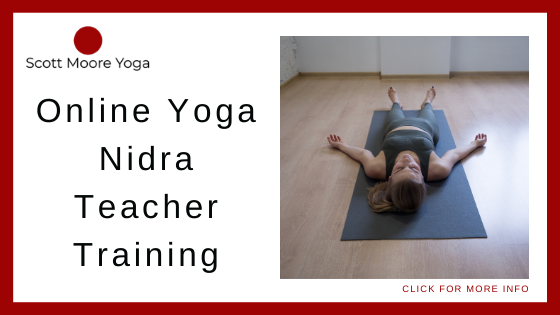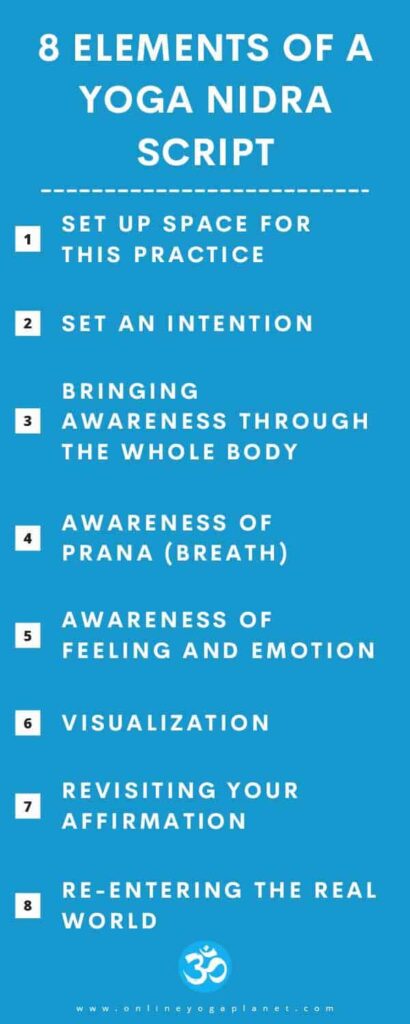
owadays, life has become hectic, and all we do is go, go, go. Yoga Nidra offers relaxation in an intensely busy life. Yoga Nidra is a special kind of Yoga that provides relaxation as deep as a non-rapid eye movement (N-REM) sleep stage. N-REM is a sleep stage without dreams, just a deep relaxation repairing of muscles and cells. Yoga Nidra takes you through all the sleep stages (creating similar stages of Yoga Nidra). A 45-minute Yoga Nidra session can offer as much relaxation as three hours of sleep.
Article Topics
Yoga Nidra will put you in a sleep-like state that allows your body to relax and heal itself. Studies show that Yoga Nidra helps in reducing anxiety and stress. It also helps with insomnia, depression, self-care, and self-love.
During Yoga Nidra, the consciousness shifts between introversion and extroversion. Sometimes it even goes into the sleep sphere. When in Nidra state, the brain waves are in-between alpha and theta waves. Once you’ve reached these states, the brain becomes more receptive.
As we practice Yoga Nidra, our consciousness connects with the unconscious and subconscious mind. This connection is vital because it awakens dormant parts of our brains and allows us to realize our potential. Usually, these parts of our brains are buried in deep parts of our brains only accessed when we reach a deep sleep state.
How Do You Write a Yoga Nidra Script?
As a Yoga teacher, you will need a script for every Yoga practice you conduct in the classroom. A Yoga Nidra script is fundamental, and one can easily tune it to have their voice or serve different purposes, such as self-love, love for others, compassion, etc.
Beforehand, you’ll have to practice using a gentle voice to avoid distracting your students. You should also find meditative and soothing sounds that will help calm your students, for example, ocean waves, rain sounds, or gentle humming of the wind.
All these elements are part of your Yoga Nidra script because, without soothing music and voice, you might not achieve the goal you need for this class.
Below we’ll be offering step-by-step tips to writing a Yoga Nidra script. You can tune all the elements to your liking.
After writing out your script, you could rehearse with your family members or friends. A rehearsal will help you figure out if there are parts of the script that needs changing. Also, the people you experiment with will help you figure out how effective it is by giving you honest pointers.
Before the Yoga Nidra scriptwriting tips, here are ways you can help students set up a relaxing environment. It doesn’t matter whether it’s on zoom or pre-recorded. When they aren’t in a studio whose setting you’ve adjusted to suit the practice, help them make their environment suitable.
- Ask them to find a quiet spot in the house without distractions and one that has dim lights or lights entirely off.
- After setting up the mat, guide them to adjust the proper temperature or cover themselves up with a blanket if needed.
- You can also ask them to set up soothing sounds that will help them relax or even light a nice-scented candle.
- They could also use a blanket or bolsters under their knees to help support them.
8 Elements of a Yoga Nidra Script
These elements should help you come up with a suitable script for your class. You can change things to have your voice as long as you incorporate all these elements.
1. Set Up Space for this Practice
Ask your students to settle down in a quiet space in the room and lay their mat. Set up a calming environment by setting a warm temperature that will help them feel relaxed. They could also dim the lights or completely turn them off to prevent any physical interference. As they finish setting up, ask them to lie down with a bolster or pillow behind the knees, close their eyes, and follow the sound of your voice.
2. Set an Intention
Guide your students in making an affirmation or intention for the practice. This Yoga Nidra stage is known as Sankalpa. The affirmation should be about something they are feeling or something they intend to feel. The intention could be something like courage, love, inner peace, or fulfillment.
3. Bringing Awareness Through the Whole Body
The primary purpose of this stage is to isolate the mind from external stimuli and senses that need attention. In this stage, you will guide the students through scanning the whole body by tensing and relaxing each muscle and joint in the body. The science behind this stage is using the principle of walking sensation through the cerebral cortex. The brain will help relax the motor and sensory regions in the brain, therefore, relaxing both the body and mind.
4. Awareness of Prana (Breath)
To do this, ask your students to concentrate on their breathing. You can do this by guiding them through belly breathing which involves breathing into your belly through the nose like a balloon then breathing out. You can even ask them to count their breaths from forty to one. Through breathing techniques, the students gradually withdraw from the physical body and continue towards the inner journey.
5. Awareness of Feeling and Emotion
This stage aims to use word association to dissolve the conditional programming in our conscious and subconscious minds. Ask the students to observe the feelings and emotions that arise without judgment. By doing this, they will eventually have willpower over those feelings and emotions. When experiencing both aspects, they will be able to release stored effects of past experiences.
6. Visualization
At this stage, we can access our unconscious minds, mental and emotional patterns. Guide your students to visualizing calming elements and observe the feelings emotions that arise from them. Be sure to be careful when choosing the object of visualization to prevent triggering negative emotions. Always choose calming scenes. Through visualization, there will be responses evoked by the relaxed mind, deep-rooted cleansing conditioning.
7. Revisiting your Affirmation
At this stage, ask the students to revisit their intentions to plant them into the unconscious mind at the beginning of the practice. Guide them to repeat the said affirmation thrice to make it stick.
8. Re-entering the Real World
In this final stage, you will help your students bring their awareness back to the physical world. Guide them through observing their surroundings with the eyes closed and awakening the body by wiggling the limbs then stretching the whole body. You can also ask them to come back to a seated position and rest there for a while as they adjust. You can close the class by asking them to bring both hands together at the heart and whispering “Namaste.”
An Example Yoga Nidra Script
- Welcome to Yoga Nidra. Find a quiet place. Laying down on your back, gently close your eyes. Take your right hand and put it on your belly and your left hand on your chest.
- Give yourself a moment and notice your breath. If you’re feeling tired or exhausted, get rid of those thoughts and labels. Be kind to your body and check in on how it feels. You can take a few breaths through your mouth to relax.
- As we go through the Yoga Nidra process, I invite you to welcome everything that comes to the surface but be the observer and don’t engage.
- Bring to attention your intention for practicing Yoga Nidra today. For example, I’m open and ready to receive an infinite flow of abundance. Repeat your intention twice more to establish your purpose today.
- Allow your awareness to pass through your whole body, as mentioned but remain still.
- Now I invite you to relax further than you already have. Relax your entire face. Move your tongue from the roof of your mouth and let it rest. Unclench your jaw. Relax your arms by allowing them to sink further into the floor. Relax your belly, chest, and back. Allow your pelvis, hips, and legs to relax too. As you go through this process, don’t try to control anything. Simply listen to my voice and allow every thought and feeling that comes to pass without engaging it.
- We are now going to focus on the feelings and sensations in our bodies. This will help sharpen our awareness.
- Notice your environment all the sounds, smells, feeling of wind on your skin, etc. Be aware of everything in your environment without judging or putting any thought into it. Just observe. Recognize your feelings, thoughts, and anything that your awareness brings up. Witness this without needing to change it.
- As an awareness, recognize the taste in your mouth. Observe the feelings in your ears. Notice how the breath feels on your nostrils. Do this to the entire face and head. Notice every single sensation.
- Now feel the sensations on your throat. Neck. Shoulders and arms. Shift your attention to travel through your left arm from the neck to the fingertips. Now do the same for your right hand. Now feel both arms simultaneously.
- Now bring your awareness to your chest, notice your breathing, and how it travels to your chest, belly, and back. Recognize all the sensations.
- Now bring awareness to your pelvis. The front, back, and both sides of it. Be aware of all feelings and sensations that arise.
- Switch your awareness to your hips and feet. Recognize the legs from the hips to the toes and repeat this on the other side: left leg, right leg. Then bring awareness, noticing both legs all at once.
- Now bring awareness to the entire left side of your body head to toe, then the right side. Do this again. Feel the whole of your left side, then right. Then feel your entire body.
- Now feel how big your body is, then feel it as small too. Just recognize both aspects. Switching from big to small. Then feel both sizes at the same time.
- Now be aware of how you’re feeling right now. Sensations can come and go. You might feel large in one moment and small in the other. Recognize a part of you that can both be large and small.
- Now be aware of everything that arises at this moment without engaging or being judgemental.
- Now, remember your intention of this practice. Repeat your intention thrice in your mind.
- We will be ending our practice in a moment. Due to this practice, you might find yourself moving back to your everyday life with focus, deep awareness, and purpose.
- In a moment, the bell will ring, and we will come to the end of our practice.
One thing that will help you learn to write scrips like this one is getting a Yoga Nidra certification online.
What Happens if You Fall Asleep During Yoga Nidra?
Yoga Nidra is a deep relaxation technique that helps you get into deeper states of consciousness and relaxation. Falling asleep during the practice beats the purpose of the practice.
When you fall asleep during Yoga Nidra, your brainwaves activity increases. When you’re awake during the practice, the brainwave activity is low, showing signs of calmness. This means that falling asleep during Yoga Nidra doesn’t serve the purpose of the practice. A short experiment conducted by Sourabh Jain brought to the surface these results.
The difference between falling asleep and staying awake during the practice is that you’re unconscious and won’t learn anything when sleeping. But when you’re awake, you’ll be able to absorb all the information and manifest your intention.
While no Yoga teacher will stop you from falling asleep during Yoga Nidra, it might be beneficial to stay awake.
Final Words
Yoga Nidra is a life-altering experience. As a yoga Nidra teacher, you should make your script as helpful and effective as possible and modify it to fit different results that you need the students to have. Following the above elements will guide you when you’re writing a Yoga Nidra script.
(Now that you’ve learned how to write a yoga nidra script, you can use it as an online yoga business idea!)





